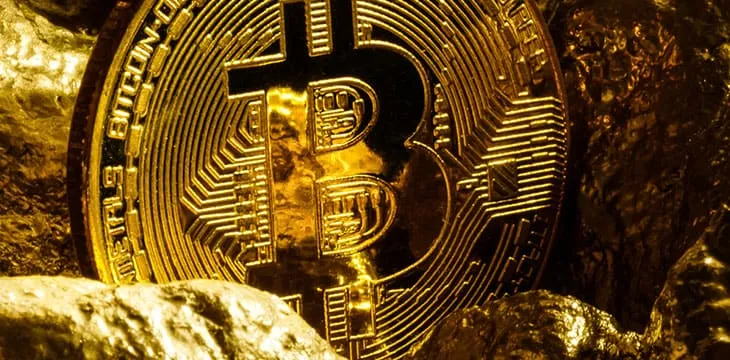|
Getting your Trinity Audio player ready...
|
This post originally appeared on ZeMing M. Gao’s website, and we republished with permission from the author. Read the full piece here.
The famous gold advocate Peter Schiff (@PeterSchiff) joins the list of keynotes at the #LDNBlockchain23. Catch Peter’s presentation, “How a digitized gold system would really work,” on the main stage Friday.
This is a much-needed talk, especially from Peter Schiff.
The digitization and tokenization of gold are really commonsensical. It only got confused due to the misleading ‘digital gold’ narrative promoted by BTC, which is not Bitcoin, nor is it the purpose of Bitcoin.
Bitcoin is, firstly technology, not money. Money is a value agreement, while Bitcoin is a technology that carries and transmits money. Bitcoin can natively transmit money directly in the form of ‘cash’ (satoshis) but can also tokenize money (such as gold) and then transmits it in the form of a token (i.e., tokenized gold).
Although it’s possible in the long future that bitcoin might gain the status of a new money itself, its first goal, as well as its first qualification, is to serve as an efficient technology that carries and transmits existing money.
I prefer the distinction between ‘money’ and ‘currency’ to express the above difference. Unfortunately, these two terms are currently used interchangeably. See Money & Currency.
Money is an agreement of value, while currency is a technology that transmits money. The requisite quality of money is value, while the requisite of currency is efficiency. It used to be that gold (its substance) was money, and standardized gold coins were a currency. That system was an improvement from the gold material being both money and currency, but not ideal because even though gold is a superb money, it is not a very efficient currency even after the gold coin standardization. The only advantage of gold coins had to offer was standardization, which was necessary but not sufficient.
Later, other forms of currencies were invented, ranging from partial-content coins to base metal coins, then to paper notes, and finally to a digital currency created through the banking system.
With the proper distinction between money and currency, in which currency is only technology, what happened in the past was progress because it improved the efficiency of currency.
In this sense, the famous Gresham’s law is a mischaracterization, which says that “bad money drives out good.” What Gresham’s law describes is really the following:
“A more efficient currency always drives out the less efficient one.”
But a tragedy happened when the distinction between money and currency was blurred and further completely disappeared.
When something that is merely a technology (currency) starts to masquerade as money, you open the door for all abuses.
That’s what happened with the fiat money, including the U.S. dollar. The dollar was first put forth as an efficient currency, legitimately, not to replace gold but to make the transmission of value backed by gold more efficiently. In this sense, the dollar was a better technology than gold coins.
But after the gold standard was abandoned, the dollar became both money and currency. It was a double tragedy. Not only is it now the value agreement (the substance of money) imposed rather than determined by a free market but also the distinction between money and currency is completely destroyed, even to economists, not to even mention the common people.
With fiat, the government started the whole thing to cheat people but ended up cheating itself as well. The society no longer understands what money is anymore.
And in a historical twist, it also laid the foundation for the misleading ‘digital gold’ narrative of BTC.
There is no need for a new gold. Gold as money is not a problem and has no problem because money is a value agreement, and the market and gold would offer a perfect value agreement unless the market is manipulated.
Gold’s problem is its lacking of an efficient and proper ‘currency’ to support it. The proper currency should take a position of a subordinate technology (subordinate because technology should not usurp its role as a currency to replace money unless, of course, it has subsequently and naturally gained the quality of money, which is a value agreement).
Bitcoin is progress which is justified to the extent that the fiat as a technology (currency) is bad because it is too unreliable and too expensive. As to the greater evil of the fiat, which further usurps the role of gold as money, the natural and acceptable part of the progress is to return the crown to the real king, which is undeniably gold today.
The gold/bitcoin as the money/currency is a perfect match, at least at the present time. If, in the future, bitcoin proves to be an even better money than gold, society will see that and accepts that. But at the present time, there is no sign that bitcoin is better money than gold. The reality does not support The Idea of “Digital Gold”.
But the genuine Bitcoin (BSV) has proven it to be not only a better currency than gold but also a better currency than all fiat.
So let the adoption, along with the match between gold and bitcoin, begin.
In contrast, what BTC wants to happen is the opposite. Imagine something that is completely inadequate as a currency claiming to be not only a currency but, more importantly, money! If it happens, it can only happen through the usurping of power and will result in something that’s even worse than the pretentious fiat.
Legitimate power has to be earned through providing quality service.
Watch: Gold as a commodity

 07-13-2025
07-13-2025 





